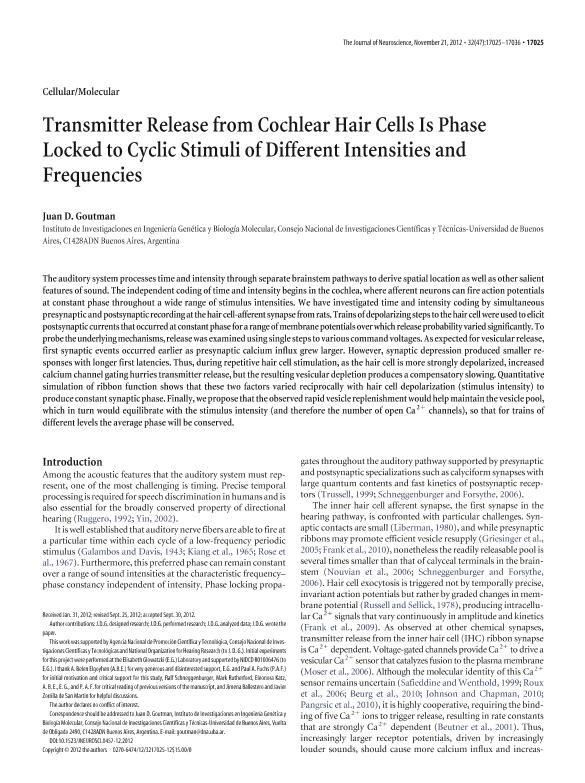Mostrar el registro sencillo del ítem
dc.contributor.author
Goutman, Juan Diego

dc.date.available
2019-07-11T17:56:57Z
dc.date.issued
2012-11
dc.identifier.citation
Goutman, Juan Diego; Transmitter release from cochlear hair cells is phase locked to cyclic stimuli of different intensities and frequencies; Society for Neuroscience; Journal of Neuroscience; 32; 47; 11-2012; 17025-17036
dc.identifier.issn
0270-6474
dc.identifier.uri
http://hdl.handle.net/11336/79365
dc.description.abstract
The auditory system processes time and intensity through separate brainstem pathways to derive spatial location as well as other salient features of sound. The independent coding of time and intensity begins in the cochlea, where afferent neurons can fire action potentials at constant phase throughout a wide range of stimulus intensities. We have investigated time and intensity coding by simultaneous presynaptic and postsynaptic recording at the hair cell-afferent synapse from rats. Trains of depolarizing steps to the hair cell were used to elicit postsynaptic currents that occurred at constant phase for a range of membrane potentials over which release probability varied significantly. To probe the underlying mechanisms, release was examined using single steps to various command voltages. As expected for vesicular release, first synaptic events occurred earlier as presynaptic calcium influx grew larger. However, synaptic depression produced smaller responses with longer first latencies. Thus, during repetitive hair cell stimulation, as the hair cell is more strongly depolarized, increased calcium channel gating hurries transmitter release, but the resulting vesicular depletion produces a compensatory slowing. Quantitative simulation of ribbon function shows that these two factors varied reciprocally with hair cell depolarization (stimulus intensity) to produce constant synaptic phase. Finally, we propose that the observed rapid vesicle replenishment would help maintain the vesicle pool, which in turn would equilibrate with the stimulus intensity (and therefore the number of open Ca 2+ channels), so that for trains of different levels the average phase will be conserved.
dc.format
application/pdf
dc.language.iso
eng
dc.publisher
Society for Neuroscience

dc.rights
info:eu-repo/semantics/openAccess
dc.rights.uri
https://creativecommons.org/licenses/by-nc-sa/2.5/ar/
dc.subject
Hair Cells
dc.subject
Transmitter Release
dc.subject
Hearing
dc.subject
Phase-Locking
dc.subject.classification
Neurociencias

dc.subject.classification
Medicina Básica

dc.subject.classification
CIENCIAS MÉDICAS Y DE LA SALUD

dc.title
Transmitter release from cochlear hair cells is phase locked to cyclic stimuli of different intensities and frequencies
dc.type
info:eu-repo/semantics/article
dc.type
info:ar-repo/semantics/artículo
dc.type
info:eu-repo/semantics/publishedVersion
dc.date.updated
2019-07-10T13:40:19Z
dc.journal.volume
32
dc.journal.number
47
dc.journal.pagination
17025-17036
dc.journal.pais
Estados Unidos

dc.journal.ciudad
Washington
dc.description.fil
Fil: Goutman, Juan Diego. Consejo Nacional de Investigaciones Científicas y Técnicas. Instituto de Investigaciones en Ingeniería Genética y Biología Molecular "Dr. Héctor N. Torres"; Argentina
dc.journal.title
Journal of Neuroscience

dc.relation.alternativeid
info:eu-repo/semantics/altIdentifier/doi/http://dx.doi.org/10.1523/JNEUROSCI.0457-12.2012
dc.relation.alternativeid
info:eu-repo/semantics/altIdentifier/url/https://www.jneurosci.org/content/32/47/17025
Archivos asociados
